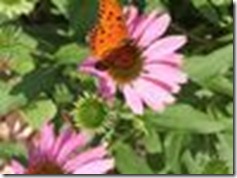-
Echinacea tennesseensis, a rare relative of the more widely found Echinacea purpurea and E. angustifolia, exists in only three counties in Tennessee. It is listed as an "endangered" species by the USGS Northern Prairie Wildlife Research Center.
A herbaceous perennial, the plant grows in rosettes the first year and flowers the second year. Buds appear in April, blooms appear mid-May and blooming is completed in October. The Tennessee Purple Coneflower requires full sunlight but tolerates less than ideal soil and can be used easily in any garden.
For Butterflies and Birds
-
Butterflies are drawn to this member of the daisy family and the seed heads provide food for birds. Tennessee Home and Farm says that these flowers are especially appealing to goldfinches.
Place the plant in a sunny spot and add other wildflowers such as glade phlox, glade sandwort, skullcap, sunnybells or flowers that share the cedar glade environment. This will create a hospitable habitat for a variety of songbirds. Add a small garden bench where you can sit and enjoy the butterfly and bird activity.
Wild Flower Garden
-
If you’re looking for a flowering plant that can tolerate heat and add color to a naturalized garden or grazing land, the Tennessee Purple Coneflower is a good choice. The plant can live for up to six years but will seed and move in a pasture or prairie.
James Newburn, curator at the University of Tennessee Gardens, says of these flowers, "They are light feeders, so once they are established, fertilizer should be kept to a minimum and competing weeds should be removed. There are few pest or disease problems and even deer don’t seem to care for them."
Easy to care for, these plants require little water, but horticulturalist at Garden Guides James Burghardt writes, "Appreciating moist, well-draining soils, the plant handles dry, hot conditions well only once established."
Cut Flowers
-
Although the Tennessee Purple Coneflower is smaller than its more readily available relatives, it is the only plant of this family with ascending petals as opposed to drooping petals, according to The Native Plants Journal. With strong, straight stems, these flowers make colorful additions to decorative arrangements.
James Burghardt suggests cutting only garden-grown plants while leaving wildflower varieties free to seed.
Borders
-
The Tennessee Purple Coneflower flourishes in open, treeless areas with rocky soil, and will grow on creek beds and around drainage ditches. It is suitable as a border for a gravel driveway, along roadsides and shoulders or in shallow soil on median strips.


Deprecated: strpos(): Passing null to parameter #1 ($haystack) of type string is deprecated in /home/agriviek8Qv/agriviet.net/public_html/wp-includes/comment-template.php on line 2522